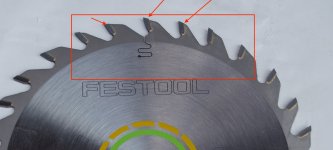- Joined
- Sep 10, 2014
- Messages
- 239
Hi Folks,
I was doing some TS55 blade measurements for an upcoming review an in the process discovered something that I hope somebody can explain. In the picture annotated below, I discovered that on Festool blades, the gullet size is consistent but the size of the metal between the carbide side of the gullet and the "front" of the gullet varies into three sizes. The distribution on the blade seems random to me. Any ideas from any of you geniuses?
[attachimg=1]
I was doing some TS55 blade measurements for an upcoming review an in the process discovered something that I hope somebody can explain. In the picture annotated below, I discovered that on Festool blades, the gullet size is consistent but the size of the metal between the carbide side of the gullet and the "front" of the gullet varies into three sizes. The distribution on the blade seems random to me. Any ideas from any of you geniuses?
[attachimg=1]

